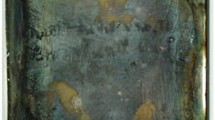Abstract
Agate/chalcedony samples of different origin were investigated by performing Raman, X-ray diffraction (using Rietveld refinement), and cathodoluminescence measurements. These analyses were performed to measure the content and spatial distribution of the silica polymorph moganite, which is considered to represent periodic Brazil-law twinning of α-quartz at the unit-cell scale in agate/chalcedonies. Homogeneous standard samples including the nearly α-quartz free moganite type material from Gran Canaria were analysed in order to compare results of the X-ray diffractometry and Raman spectroscopy techniques and to provide a calibration curve for the Raman results. However, due to the different length scales analysed by the two techniques, the “moganite content” in microcrystalline SiO2 samples measured by Raman spectroscopy (short-range order) was found to be considerably higher than the “moganite content” measured by X-ray diffractometry (long-range order). The difference is explained by the presence of moganite nanocrystals, nano-range moganite lamellae, and single Brazil-law twin-planes that are detected by vibrational spectroscopy but that are not large enough (in the sense of coherently scattering lattice domains) to be detected by X-ray diffractometry. High resolution Raman analysis provides a measure of the moganite content and its spatial variation in microcrystalline silica samples with a lateral resolution in the μm-range. Variations in the moganite-to-quartz ratio are revealed by varying intensity ratios of the main symmetric stretching-bending vibrations (A1 modes) of α-quartz (465 cm−1) and moganite (502 cm−1), respectively. Traces of Raman microprobe analyses perpendicular to the rhythmic zoning of agates revealed that the moganite-to-quartz ratio is often not uniform but shows a cyclic pattern that correlates with the observed cathodoluminescence pattern (colour and intensity). Data obtained from an agate sample from a fluorite deposit near Okorusu, Namibia and from a volcanic agate from Los Indios, Cuba were selected for detailed presentation. Variations of cathodoluminescence and Raman data between single bands in agates suggest alternating formation of fine-grained, highly defective chalcedony intergrown with moganite, and coarse-grained low-defect quartz. Multiple zones indicate dynamic internal growth during a self-organizational crystallization process from silica-rich fluids.
Similar content being viewed by others
Author information
Authors and Affiliations
Additional information
Received: 4 December 1997 / Accepted 19 June 1998
Rights and permissions
About this article
Cite this article
Götze, J., Nasdala, L., Kleeberg, R. et al. Occurrence and distribution of “moganite” in agate/chalcedony: a combined micro-Raman, Rietveld, and cathodoluminescence study. Contrib Mineral Petrol 133, 96–105 (1998). https://doi.org/10.1007/s004100050440
Published:
Issue Date:
DOI: https://doi.org/10.1007/s004100050440




